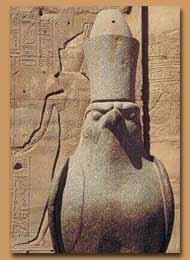|
When
studying the religion of the ancient Egyptians, we are
confronted with a multitude of gods, represented in
a variety of ways. In order to understand their mythology,
we must first attempt to understand how the ancient
Egyptians viewed their gods.
The Egyptians' concept of "god" is not easy
to define. There were many gods and goddesses, many
of them representing different aspects of life and nature.
Hence Osiris was the god of the dead; Hathor was the
goddess of love, procreation, wine and music; Isis was
the goddess of motherhood, and so on. However, not all
gods represented exclusively good aspects of life. Sekhmet,
for instance, represented vengeance and disease whereas
Seth represented the desert and chaos. Nevertheless,
this does not mean that Sekhmet or Seth were viewed
solely as bad gods: Seth plays an important part in
the protection of the deceased solar god during his
journey through the underworld every night.
Despite the multitude of gods, there has been some debate
whether or not these seemingly different gods could
represent different aspects of the same god. Many gods
were associated with the solar-god Re, thus turning
them into solar-deities as well and making them share
some of the same characteristics. As Egyptian religion
evolved, more and more gods were assimilated into each
other, while still retaining their individuality. Hence
Khonsu and Thot, both lunar deities, could be assimilated
into Khonsu-Thot, a lunar god with both Khonsu's and
Thot's characteristics while both Khonsu and Thot continued
to exist individually. Such "syncretism" makes
it difficult to understand the individual characteristics
of the different gods.
Gods could also share some characteristics without being
explicitly associated with each other. Several important
cities would, for instance, promote their own, local
god as the creator of the world: Atum in Heliopolis,
Ptah in Memphis, Amun in Thebes, … were all credited
with having created the world and each of them had their
own creation myths.
Basically there were male and female deities. Several
deities, however, could be considered as having both
genders. Shu, the god of the air, for instance, can
sometimes be represented as a man with breasts, whereas
the goddess Neith is said to be 2/3 male and 1/3 female
but she is always represented as female. Gods with bi-sexual
traits were often creator-gods who needed both the male
and the female aspects to be able to create the world.
The ancient Egyptians often grouped their gods. The
smallest group consisted of two gods, generally composed
of a male and a female deity.
More
typical were triads, consisting of 3 gods, usually in
a father-mother-son relationship. The most popular triads
were Osiris-Isis-Horus and Amun-Mut-Khonsu.
An
Ogdoad grouped 8 gods, 4 times a couple, each couple
representing the male and female aspects of the elements
that were present before creation. Unlike other groupings,
the Ogdoad consisted of specific gods, which will be
discussed in the upcoming article on Creation Myths.
An
Ennead normally consisted of 9 gods, but as 9 is 3 times
3 and 3 was viewed as "plural", an Ennead
could also be viewed as a gathering of many gods. The
most important Ennead was located at Heliopolis, to
the northeast of Memphis. Several cities had their own
versions of the Ennead of Heliopolis, some headed by
the principal god of that city, others just "copies"
of it, to which some local gods were added.
The
reasons why some gods were grouped together are not
always clear. Sometimes, gods in a group have similar
or complementing characteristics, as was the case with
the Ennead of Heliopolis, for instance where the first
5 gods represented an element of nature (sun, air, moisture,
sky and earth). The relationship between Ptah, Sekhmet
and Nefertem, the members of the Memphite triad, however,
is not really clear.
One of the most striking features of ancient Egyptian
gods is the way they were represented. They could be
represented as humans, humans with the heads or other
features of animals, as complete animals, as plants
or even as objects. Amun, for instance, is usually shown
as a man wearing a crown with high feathers, but occasionally
is depicted as a man with the head of a ram. Horus,
on the other hand, can be represented as a human child,
as a man with the head of a falcon or as a falcon. One
form of Horus, Horus of Edfu, is often represented as
a winged solar disk.
Even more fantastic are gods like Tutu, a winged lion
with the head of a man, a crocodile extending from his
chest and a snake-shaped tail.
|
 |
|
"Two
times Horus: the statue in the foreground represents
him as a falcon, the relief behind the statue
shows him as a man with the head of a falcon"
|
|
Strange as such representations might seem at first, they
are more indicative of the nature of a god rather than
what he looked like. Hence Horus was associated with a
falcon, because primarily, he was a god of the heavens.
He was also a powerful and strong god, so he wasn't associated
with just about any bird, but with the most dangerous
bird of prey known to the Egyptians.
Anubis was represented as a man with a dog's head, or
as a dog, because dogs were associated with places of
burial. He was black because black was the colour of death.
Hathor, usually represented as a female, is sometimes
represented as a woman with cow's ears, as a woman with
a cow's head or as a cow, because she was the goddess
of procreation, fertility and motherhood.
Because we do not always know what characteristics the
Egyptians associated with animals, we can not always explain
why a particular deity was associated with a particular
animal and represented as such. We do not know, for instance,
why Thot, the god of wisdom and writing, was associated
with an ibis. |